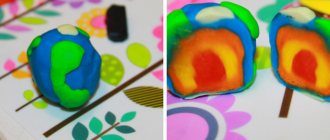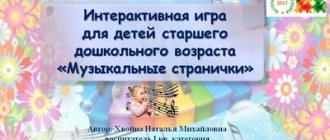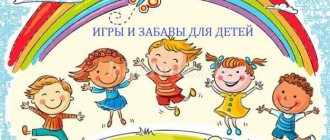What is the fastest way to learn letters with your child? The easiest way is to hang a poster with the alphabet on the wall and regularly voice it to your child... But... this method does not work for all children! Unfortunately, many children get bored very quickly and simply “run away” from such activities.
If you find yourself in such a situation, don’t despair! There are many fun letter learning games that your child will love!
Before you start learning letters, it is important not to forget:
Most preschool teachers agree that it is best to teach children the “sound” interpretation of letters (not “Ka” but “K”, not “Be”, but “B”, etc.).
This is done so that later it will be much easier for the child to learn to add syllables.
Compare in which case it will be easier for a child to “figure out” how to form a syllable:
Sound option: “B” + “A” = “BA”
Letter version: “Be” + “A” = ????? - according to the logic of things, children often want to say “BeA” in this place, and this is where the main problem arises that many parents face when they teach their children the “classical” names of letters (such as “Be” “Ve”, etc. .) - when reading syllables, it is difficult for a child to mentally discard the sound “a” from “Ka”, the sound “e” from “Ve”, etc. (they want to read not “VA”, but “VEA”, not “BU”, but “BeU”, etc.)
And this complexity becomes a serious obstacle to teaching a child the skill of combining individual letters into syllables.
Therefore, studying the “sound” interpretation of letters will be much preferable.
So:
Let's color it.
Everything is simple here! You can download coloring pages with letters from the Internet and invite your child to color them. The child will engage in creativity with interest, and at the same time consolidate knowledge about the new letter.
To prevent the child from getting bored with the coloring process, you need to use various interesting techniques:
- color letters not only with pencils, but also with paints, wax crayons, and stamps;
- paint with your fingers using finger paints;
— use non-traditional drawing techniques ( with cotton swabs, crumpled paper, blots, etc.).
2. Decorate the letter.
Children will have fun decorating the letters!
You can decorate them with plasticine, applique, colored glass, construction kit parts... whatever you want!
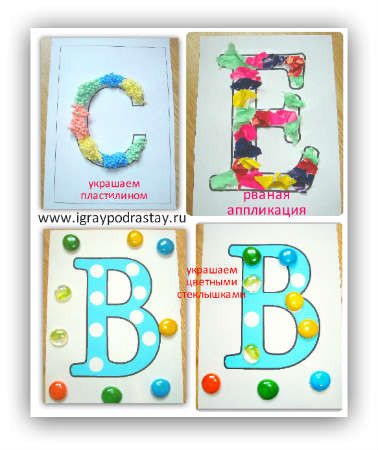
Try decorating the letter “A” with watermelons, the letter “B” with bananas, etc.
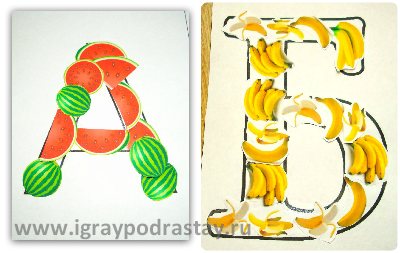
How to teach a child the alphabet at 3-4 years old
If you decide to teach your child letters at 3 years old, remember that nothing can be done through force, only games, only entertaining exercises and NO FORCE. These recommendations are relevant for any age, because you do not want to develop an unwillingness to learn and go to school in the future.
- Don't expect your child to remember many letters right away. Don't set out to learn the entire alphabet; it will take time.
- Give your child new material twice a week, and on the remaining days, repeat and consolidate what you have learned.
- With a child 3-4 years old, it is enough to exercise 2-7 minutes a day.
- Learn vowels in pairs, so it will be easier for your child to remember: A - Z, O - Yo, U-Yu, Y - I, E - E.
- Before introducing your child to consonants and starting to learn to read, make sure that knowledge of all vowels has been brought to automaticity.
Let's sculpt.
A very useful activity is to sculpt letters from colored dough or plasticine. And if you combine sculpting with listening to Ekaterina Zheleznova’s songs from the album “Musical Primer” (in which the whole sculpting process is “sung” in a very interesting way), then sculpting will be even more fun.
Wonderful mothers, passionate about the development of children, have long made funny videos from these songs and posted them online.
For example, while playing and watching a funny video, you can make the letter A in a fun and interesting way:
Tilt two sticks
Connect at the top
One crossbar -
Like a letter A tent!
Halves is a game to consolidate knowledge about already familiar letters.
In the process of learning the alphabet, the process of repetition is important. Still would! After all, by the time you get to “I”, you must try not to forget the letter “A”.
The process of repeating already learned material will be more fun with the game “Halves”!
Cut out beautiful cards with letters, cut them into two parts, mix them.
Invite your child to “fold” letters from two halves.
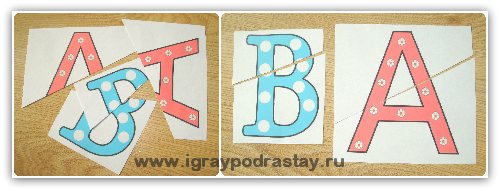
Memory.
To consolidate the material covered, the well-known game “Memory” is also suitable (at the same time, attention and memory are trained). You will need a set of cards in which each of the pictures with a certain letter is presented in duplicate.
Shuffle the cards and place them in front of the child, white side up.
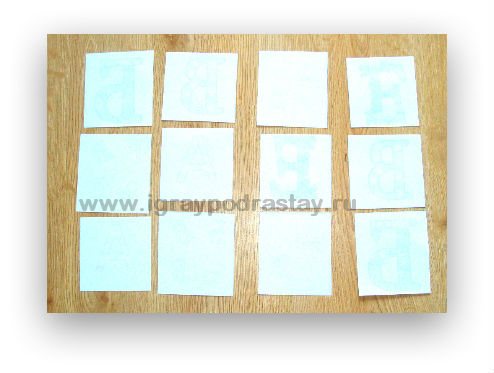
Ask him to turn over any of the cards, name the sound that the open letter represents. Then the player needs to find exactly the same card among the others that have not yet been turned over. The player looks for the desired letter by turning over the remaining cards and checking what is written on them.
Did you open the wrong letter? Turn it back to the white side up and look for a pair further!

When the required card is found, the player takes two cards for himself and the game continues until a pair is found for each card.
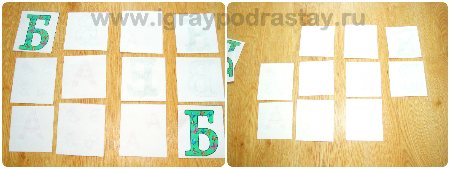
Lotto and foil.
Another way to study and repeat letters is lotto.
Not all children are enthusiastic about letter lotto. In order to interest the child in this game, you can use foil or paper.
Prepare the playing field, and also wrap the letter figures in foil or paper.
Invite your child to unfold the letter and place it in its place on the lotto playing field.
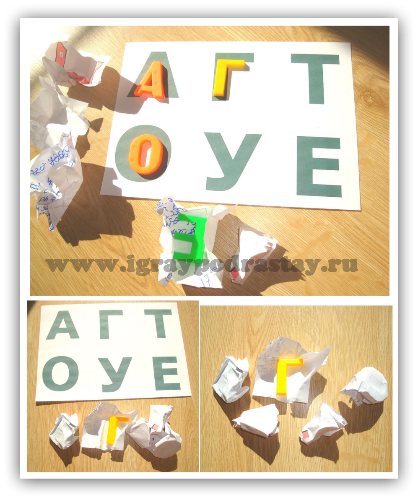
Lotto can be sound - in this case you need to put a letter on a card on which an object is drawn that begins with this letter.

Online alphabet learning programs for children
Some parents believe that a computer can harm their child. Now these views are outdated. It can become a reliable and effective assistant in teaching children the alphabet. There are many such sites. Here are some of them:
- The website https://dodosha.rf/alphabet/ presents several educational programs for kids. "Talking Alphabet" tells children what letters sound like. The Jolly Engine helps them form words. The site also contains other educational games on the topic in question.
- The link https://online-azbuka.ru/ has online games that will help in learning the alphabet. For example, you can select a letter and go to the page dedicated to it. When you click on the desired picture with the mouse, the child’s voice pronounces it loudly and clearly or gives an example of pronunciation as part of the word.
Note! Such games can not only teach a child, but can also bring pleasure and captivate him. It is recommended to start learning the alphabet as early as possible. Classes should be based on the child’s passion and parents’ support for his success.
Letter eater.
A cheerful Bukvoeshka may appear in your home. The easiest way to do this is to take a glove doll or a soft toy.
For example, this cockerel -
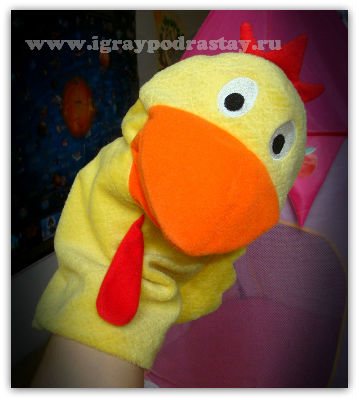
very unusual! He eats letters! Come on! Let him eat the letter B! And now he wants the letter A! Oh, how deliciously you feed the cockerel!
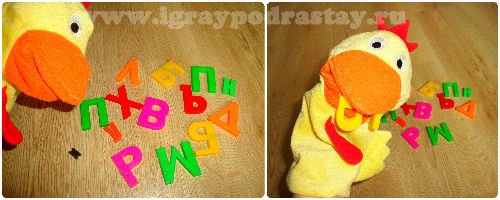
You can play the letter game in another way:
Funny people live in this box. They eat nothing but letters. Let's feed them? (the little people’s mouths are slits in the box).

Here is their food (we draw letters on the beans with a felt-tip pen):

We feed the little men (each little man has his own letter, if the baby makes a mistake, the little men spit merrily, close their mouths and demand to be fed another food that suits them better (beans with “their” letter):

Where is it better to start (step-by-step training)
When conducting classes, it is important to determine the sequence of training. In this case, you need to pay attention to the following:
- During the initial learning of letters, there is no need to master them in accordance with the order in which they are located in the alphabet.
- Since vowels and consonants differ significantly in pronunciation, there is no need to study them together.
- It is recommended to start studying vowels at the beginning of your studies.
- Consonants are more difficult for a child to learn than vowels and cannot be learned at first.
- When teaching kids, you need to take into account the difference between the name a letter bears and how it sounds in words. It is important that the child learns the second first. This can help when learning to read in the future.
Card index of topics for conversations in the senior group and for situational conversation
Important! Watching educational cartoons will help. For example, you can choose where it is shown how to learn letters with the help of Luntik.
Why is it important to learn 10 vowels well?
When a child takes the first steps in learning to read, he will not be able to read words if he does not know how to pronounce the vowels correctly. When reading words, he will stammer every time he encounters them in a word. It is important that the baby first understands well what all 10 vowel letters look like and how to pronounce them. This will serve as a solid foundation for further learning.
How to learn consonants
When studying them, they begin by introducing them to the sound and only then to the name of the letter in the alphabet. It is recommended to name consonants without accompanying sounds: not “EM”, but “M”. This will serve as a basis for further study of letters. You need to show your child the letters he knows in books and pronounce words with their participation.
Note! During walks, pay attention to signs or advertisements, ask the child to find familiar letters in them and pronounce them. When asking what letter he saw, he must be praised for the correct answer.
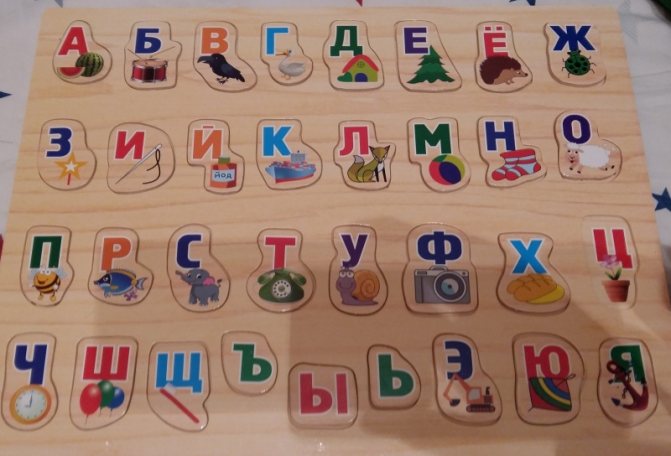
Wooden frame for letters
If this kind of activity is carried out regularly and unobtrusively, the baby will gradually master all the letters and will be able to easily recognize them.
We design.
We lay out the silhouettes of letters from counting sticks, matches, Lego and everything else that comes to hand:
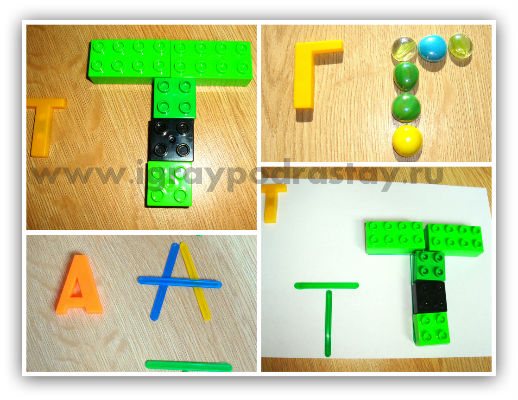
Some children may find it difficult to form letters from available materials (especially if the child is under 3.5 years old).
With such children you can design using the “overlay” method.
To do this, you can draw these simple diagrams:
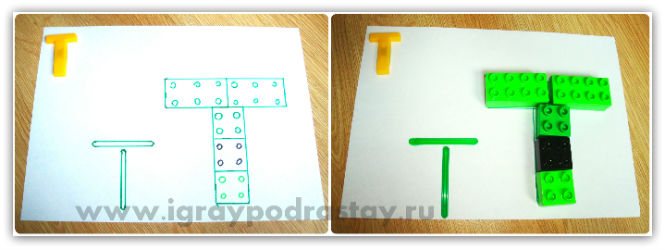
Also, in order to build letters, you can use the Zheleznovs’ musical primer, which was already written about in paragraph 3 of this article.
For example, the poems and song that are described in paragraph 3 for “A” can also be used to construct this letter from sticks (Tilt two sticks, connect them at the top, one crossbar - like the letter A in a tent!)
Songs to learn the alphabet - video
Songs help you learn the alphabet and remember letters faster and easier. To a cheerful, simple melody, the characters sing about the letters, arranged in the same order as in the alphabet. Get your child interested in the video and offer several options to choose from. Let the child choose the song himself.
If the child is attentive and not only listens, but also watches the video series, choose a song with bright pictures and memorable characters.
your child often get distracted while watching ? A song with only lyrics is enough.
Tip : You can listen and watch videos every day in the first half of the day, when information is perceived easier and faster.
Outline.
This is a great game for learning how to write letters.
Draw the letter with paints. And then ask your child to circle it with a different color... or several colors. Of course, it is better to draw the letter on an A4 sheet.
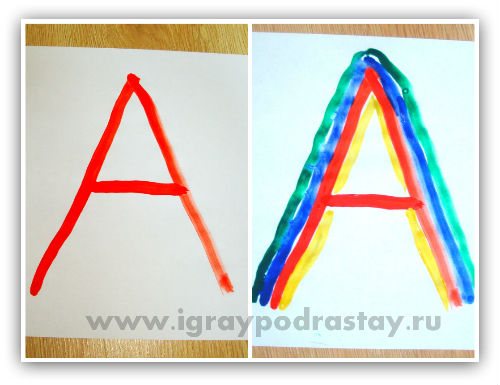
You can even “write” entire words this way:
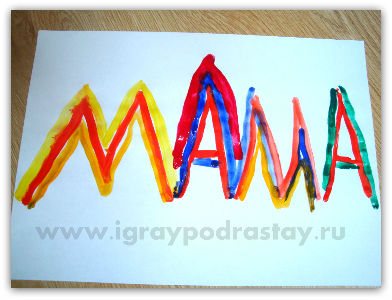
"Find it!"
Find all the letters “K” in this picture and circle them!
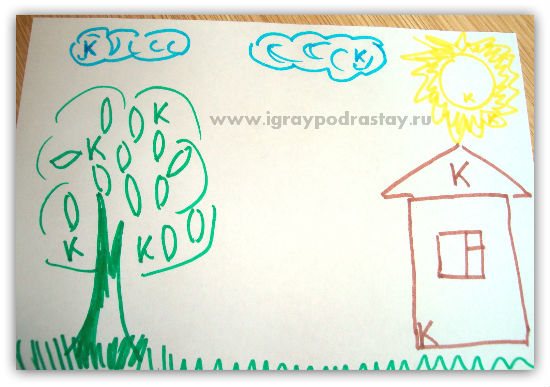
And in this picture there are all the letters “T”:

Find all the red letters “M”... And now the blue ones... And now the orange ones, etc.
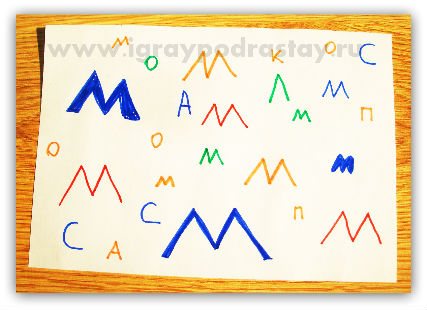
Now count - how many letters “M” did you find in total?
Reading syllables of varying complexity
When moving from learning letters to reading sentences, correctly pronouncing syllables is an important developmental milestone. At the same time, it is important to show the child how words are formed from the sounds of letters.

Set of letters to study
Important! When learning syllables, it is important to accurately pronounce them out loud, reinforcing pronunciation. Subsequently, based on what you have learned, you can move on to reading words and sentences. Educational cartoons can help in mastering the pronunciation of syllables, for example, “The ABC with Cars.”
Games with mosaics.
Lay out the letter from the mosaic according to the example:

A simpler and more interesting option:
Roll out the dough, draw a letter on it with a felt-tip pen... and decorate it with a mosaic!
You can also decorate the letters on the dough with other items, such as cereal:

Outdoor game “Run to the letter”
The good thing about this game is that it's dynamic - it's more like a fun game of catch-up rather than a learning process. It can be used instead of a mobile pause in class to have a useful rest.
Hang pictures of different letters on the walls of the room (you can use letters that you “decorated” with your child).
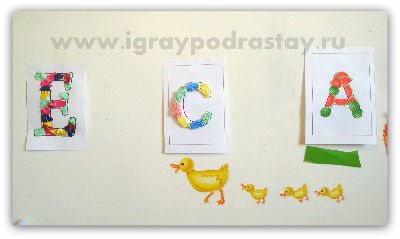
Now we give the child the command: “Run quickly, quickly to the letter C!”
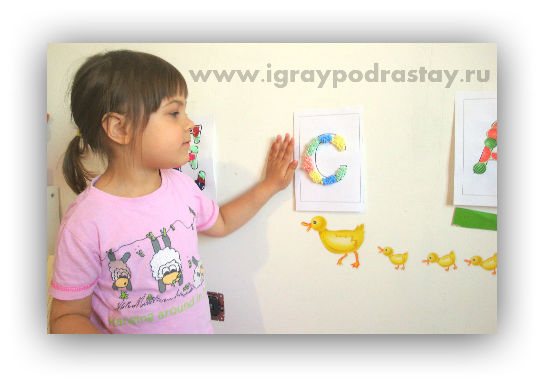
And now to the letter “A”!
This game not only helps you learn letters in motion, it also develops attention and memory.
If a child refuses to run at your command, you can take him by the hand and run with him.
A very interesting variation of this game was invented and offered on her website by Natalya Chistokletova (link to source). This is the game “Cover the letter with your palm”:

Game "Feed the Monster":
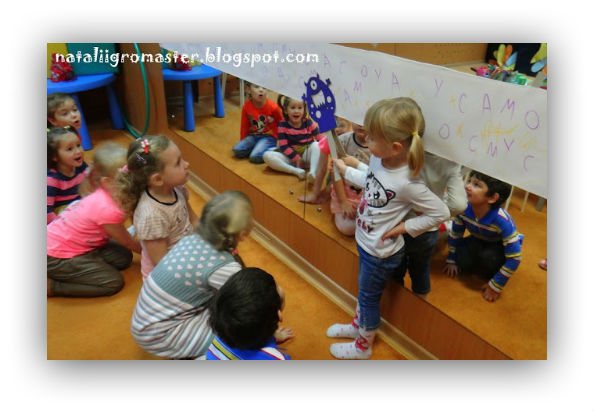
17. Outdoor game “Jump-jump-team!”
This game is also active, and therefore children also love it!
Do you remember the funny program “Jump-Jump-Team” on the “Carousel” channel?
You can play “jump-jump-team” with letters!
Let's take a cube with letters! (if you don’t have one ready-made, you can make it.... Well, as a last resort, just turn the cards with the letters face down and pull them out one at a time).
For example, this simple cube can be made using a children's cube, tape and paper:
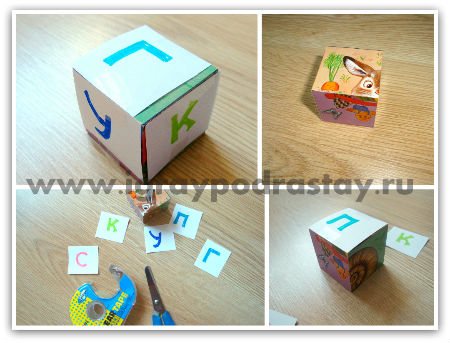
Let's throw the dice... What have we got? Yeah! "U".
What happens with “U”... Snail? Let's show her (we put a pillow on our back and start crawling on the floor).
Now what? Letter "C". At "C" we have an elephant! Let's show it too!
Learning letters is fun. 18 useful games for kids
Olga Valerievna Fedotova
Learning letters is fun. 18 useful games for kids
What is the fastest way to learn letters with your child ?
The easiest way is to hang a poster with the alphabet on the wall and regularly read it to your child.
But this method does not work for all children. Unfortunately, many kids get bored very quickly and simply “run away”
from such activities.
If you find yourself in a similar situation, do not despair. letter learning games that your child is sure to love.
Before you start learning letters, it is important not to forget : most teachers agree that when learning letters , it is best to memorize their “sound”
interpretation: not
“Ka”
but
“K”
, not
“Be”
, but
“B”,
etc. This is done so that later it will be much easier for the child to learn to add syllables.
Compare in which case it will be easier for a child to figure out how to compose a syllable:
Sound option: "B"
+
“A”
=
“BA”
Letter version : “Be”
+
"A"
=?
Logically, children often want to say “BeA”
, and this is where the main problem arises, which many parents face when they teach their children
“classical”
names
of letters like “Be”, “Ve”,
etc. - when reading syllables, it is difficult for a child to mentally discard
the sound
“Ka” from “Ka” . a”
, from
“Ve”
- the sound
“e”
, etc. They want to read not
“VA”
, but
“VeA”
, not
“BU”
, but
“BeU”
, etc.
And this complexity becomes a serious obstacle to teaching a child the skill of combining individual letters into syllables . Therefore, learning the sound interpretation of letters will be much preferable.
1. Coloring
Everything is simple here. You can take coloring pages with letters and invite your child to color them. The child will engage in creativity with interest, and at the same time consolidate knowledge about the new letter .
To prevent the child from getting bored with the coloring process, you need to use various interesting techniques:
• color letters not only with pencils, but also with paints, wax crayons, and stamps;
• paint with your fingers using finger paints;
•use non-traditional drawing techniques: with cotton swabs, crumpled paper, blots, etc.
2. Decorate the letter
Children will be happy to decorate the letters . You can decorate them with plasticine, applique, colored glass, construction kit parts, etc. Whatever you want! Try decorating the letter "A"
- watermelons,
the letter “B”
- bananas, etc.
3. We sculpt
very useful activity is to sculpt letters from colored dough or plasticine.
4. Halves - a game to consolidate knowledge about already familiar letters
Repetition is important in learning the alphabet. Still would! After all, by the time you get to “I”
- We must try
the letter “A”
.
Repetition of already learned material will be more fun with the game "Halves"
.
Cut out beautiful cards with letters , cut them into two parts, mix. Invite your child to “fold” letters from two halves .
5. Game "Memory"
“Memorization” is also suitable for consolidating the material covered.
.
At the same time, attention and memory are trained. You will need a set of cards in which each of the pictures with a certain letter is presented in duplicate.
Shuffle the cards and place them in front of the child, white side up. Ask him to turn over any of the cards, name the sound that the open letter . Then the player needs to find exactly the same card among the others that have not yet been turned over. He looks for the right letter by turning over the other cards and checking what is written on them. Did you open the wrong letter ? Turn it back with the white side up and look for a pair further. When the required card is found, the player takes two cards for himself and the game continues until a pair is found for each card.
6. We write on semolina
Children love to draw on semolina. Without exception, everyone - from small to large. Even if your child is already 10 years old and seems so big already, believe me, he will be delighted with drawing on semolina.
7. Lotto and foil
Another way to study and repeat letters is lotto .
enthusiastic about . In order to interest the child in this game, you can use foil or paper.
Prepare the playing field , and also wrap the letter . Invite your child to unfold the letter and put it in its place on the lotto playing field . Lotto can be sound - in this case you need to put a letter on a card on which an object is drawn that begins with this letter .
8. Letter eater
A cheerful Bukvoeshka may appear in your home . The easiest way to do this is to take a glove doll or a soft toy. For example, a bear is very unusual. He eats letters . Come on, let him eat the letter "B"
.
And now he wants the letter "A"
. Oh, how deliciously you feed the bear!
the letter game in another way. Funny people live in this box. They eat nothing but letters . Let's feed them. The little people's mouths are slits in the box. Here's their food: we draw letters with a felt-tip pen on the beans and feed the little people. Each person has his own letter . If the baby makes a mistake, the little men spit cheerfully , close their mouths and demand to be fed another food that suits them better: beans with “their”
letter .
9. We design
We lay out silhouettes of letters from counting sticks , matches, Legos and everything else that comes to hand. Some children may find it difficult to form letters from scrap materials, especially if the child is under 3.5 years old. With such children you can design using the “overlay”
. To do this, you can draw simple diagrams.
11. Pierce
Draw a letter on paper . Place a piece of paper on the carpet or soft sofa and hand your child a toothpick. The object, of course, is sharp, but in 90% of cases children easily learn safety precautions and no problems arise. Ask him to decorate the letter with holes: pierce the letter along the contour .
12. Outline
This is a great game for learning how to write letters . Draw the letter with paints . And then ask your child to circle it with a different color or several colors. The letter , of course, is better to draw on a thick A4 sheet. “write” this way
whole words.
13. Connection of letters and sounds
What sound does “Elephant”
?Correct: on
“C”
.
Where is our letter "C"
? Let's give it back to the elephant! And so on.
14. Find it!
Find all the letters "K"
and circle them.
15. Games with mosaics
Lay out a letter from the mosaic according to the sample. Or a simpler and more interesting option: roll out the dough, draw a letter on it with a felt-tip pen and decorate it with a mosaic. You can also decorate the letters For example, cereal.
16. Outdoor game “Run to the letter ”
This game is good because it is active - more like a fun game of “catch up”
rather than on the learning process. It can be used instead of a mobile pause in class to have a useful rest.
Hang pictures of various letters . You can use letters that have been "decorated"
together with the child.
And now we give the command to the child: “Run quickly, quickly to the letter C !”
.
And now - to the letter "A"
!
This game not only helps you learn letters in motion , it also develops attention and memory.
If your child refuses to run at your command, you can take him by the hand and run together.
17. Outdoor game “Jump-jump-team!”
This game is also active, and therefore children love it very much.
Take a cube with letters . If you don’t have one ready-made, you can make it. Well, as a last resort, just turn the cards with the letters face down and pull them out one at a time. The cube can be made using a children's cube, tape and paper.
Let's throw the dice. What have we got? Yeah! "U"
.
What happens with "U"
? Snail. Let's show her: put a pillow on her back and start crawling on the floor.
Now what? Letter "C"
.
At "C"
we have an elephant! Let's show it too.
18. Sound poster
The meaning of its action is simple - the child clicks on the picture with the letter , and the poster pronounces the sound that it represents.
The only "But"
- it is better to buy posters that work in the mode of studying not the names of
letters , for example “Ka”
,
“Sha”
,
“Be”,
etc., but the names of the sounds that these
letters : not “Ka”
but
“K”
, not
"Be"
, but
"B"
.
The advisability of such a study was already discussed at the beginning of the article. posters that offer the “sound”
sound of each
letter .

